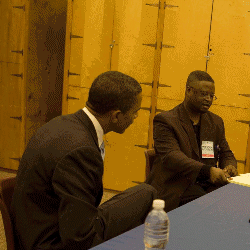ONUMBA.COM, USA – Somali immigrant Ismahan Isse loves Columbus. Isse is part of a sprawling Somali community that is second largest in the nation, behind only Minneapolis-St Paul metropolis. She wants to serve the city as a police officer. And the good thing about Isse wanting to become a cop is that it will help Mayor Michael Coleman achieve his goal of creating a force that is as diverse as the city.
But for Isse and Coleman, there’s one little problem.
Isse is a Muslim woman, and with that comes a smorgasbord of requirements imposed by her Islamic faith, including the fiercely forbidden practice of not going out in public without wearing head-scarf, also called hijab. Unfortunately, that iron-clad religious ukase not too long ago collided head-on with the decision by Columbus Police Chief Kim Jacobs to ban women on the force from wearing head-scarf while on duty or training.
While Coleman stands with Jacobs concerning her decision, he also recognizes the problem of lack of diversity bedeviling the force, which explains why he is pushing efforts to ensure that his administration is reaching out and encouraging all residents of the city to join the force.
“I’ve said this to our chief and safety director, to step up our efforts in this area,” said Coleman in a recent interview, adding, “I strongly believe that our police force needs to be reflective of every corner of our city.”
Currently, the police force is nowhere near that level of reflection, but the mayor’s intention clearly underscores acknowledgement of the problem and more importantly the mission of his administration to solve it, mindful of how diverse the city has become over the years lacking adequate representation on the police force.
But while Coleman’s egalitarian intention soothes and calms the tension fueled by the controversy, it still doesn’t help Isse move any closer to achieving her goal of becoming a police officer, because there’s still the hijab ban that is thwarting her dream of joining the police force.
While Isse remains committed to becoming a police officer, she refuses to sacrifice her sacred obligations to the Islamic faith to achieve her career goal.
Isse’s saga started in March after she left the Columbus Police Academy to protest a policy requiring her not to wear her hijab while pursuing training.
She said she won’t return to the academy with the hijab ban in place.
And therein lies the conundrum.
Columbus police leaders are maintaining their posture, arguing that the hijab ban is hugely essential for the city to achieve its goal of creating a force that is non-political, non-religious, non-ethnic and a force that is completely uniform.
In their eyes, allowing head-scarfs on the force signifies a profound departure from that corporate vision, fearing that it could lead to a slippery slope to the possibility that other ethnic or religious accommodations could be next.
Coleman feels the same way.
“When officers go out into the community, they should be identified as Columbus police officers, not Muslim police officers, not Christian police officers, not Jewish police officers, not Hindus, Baptists or anything else,” Coleman said.
Coleman’s administration has been mightily friendly to the city’s immigrant community, which probably explains why there’s some dovish consensus by some involved in this saga to resolve the issue through dialogue.
Hassan Omar, a longtime leader in the Columbus Somali Community and President of the Somali Community Association of Ohio, would like to see the ban on head-scarf lifted, but at the same time, he eyes a broader solution to the problem, urging an immediate focus by the city on diversifying the force with minorities.
“It’s an honor to be a police officer, and many young Somali men and women want to serve but aren’t given a chance or encouraged to apply,” said Omar.
According to Chief Jacobs, about 12 percent of the force is African-American. She gave no figure of how many immigrants are serving on the force as cops.
As for Minneapolis-St Paul metropolis, there are 12 Somali officers there, some of them transit officers.
An estimated 40,000 Somalis live in Columbus.








